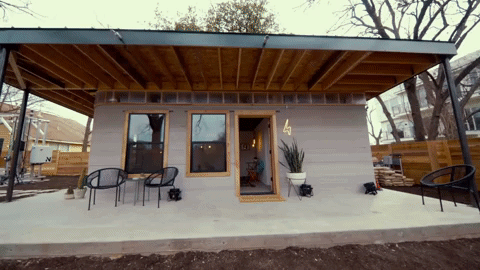
One story blew all other 3D printing news out of the water this month, and it came from South by Southwest. But, it wasn’t the only inspiring, gripping, and forward-looking tale we’re here to share. So get ready for houses, lenses, spaceships, and more, all this month in 3D printing.
The Housewarming Party Heard ‘Round the World
We’ve been making huge advances recently (‘we’ being humans) in printing structures. From bridges to bus shelters, these experiments have been pretty literally laying the foundation of all the 3D printed structures to come. Then, this month, SXSW happened. And during the always-hyped 10-day festival of innovation, music, film, and whatever else the organizers decide, New Story and ICON’s 3D printed house stole the show. Developed to eventually cost $4,000 and take no more than 12-24 hours to print, it’s destined for use in developing areas that need sturdy housing. The quick-drying cement used by Icon’s specially-produced Vulcan printer is stronger than traditional concrete. Plus, the house’s desert-chic aesthetic is so hot right now.
Take the full tour below:
Italian architect Massimiliano Locatelli has been teasing a similar 3D printed showplace to be unveiled during next month’s Milan Salone del Mobile — this time with fancier fixtures. Follow his Instagram for updates and, we hope, unbearably chic instas from the show.
It’s actually rocket science
Why 3D print a rocket? “Rockets are the lightest-weight, most expensive, largest, difficult-to-make thing, that really 3-D printing is the optimal solution for.” That’s coming from Relativity co-founder Tim Ellis, whose company is using the largest metal 3D printer in the world to construct rocket elements (today) and fully 3D printed spacecraft (tomorrow). The printer is (super-nerdily, super-awesomely) named Stargate. Learn more at Futurism, and watch PBS’s interview with Tim Ellis (and other 3D printing wizards) below.
Put these contacts in with your robot hand
Researchers at Northwestern University worked their butts off to solve the trickiest of challenges: creating smooth, layer-less lenses with our favorite layer-by-layer manufacturing technique. After more than 100 tries, the resulting lenses are low-cost, high-quality, and fast-printing. Said Cheng Sun, whose lab developed the process, “Up until now, we relied heavily on the time-consuming and costly process of polishing lenses. With 3D printing, now you have the freedom to design and customize a lens quickly.” This means custom contact lenses, microscopes on iPhones, better imaging during things like endoscopic surgeries — but probably not better selfies.
But what about this robot hand? It’s actually the first fully 3D printed bionic arm, and thanks to Open Bionics, it will be available in April for purchase. The Hero Arm can be endlessly customized in terms of its appearance and fit, and it’s much, much cheaper than the next-least-expensive bionic arm on the market. The name derives from the fact that the company has custom-made a few prototypes that are based on superhero characters. But, an inexpensive bionic arm is also kind of a hero in and of itself. See it in action (hero mode) below.
Even better than the ugly sneaker trend
The 3D printed shoe proto-trend became even more fun this month when Reebok got into the game with its Liquid Floatride sneaker drop. Adidas, New Balance, and Under Armour have already brought some offerings to market, and now that Reebok’s Liquid Factory (where a proprietary material is responsible for the kicks’ 3D printed elements) is up and running, our 3D print-shod future is looking so, so cool.
3D Print Your Robotics Needs
Learn how you can utilize 3D printing for robotics use. Contact us today to let us know how we can help.



A couple of months ago, you sent out pictures of products some of your other customers were making, I would like to buy some of their copies, but don’t have the address.
Hi Ed! Any of the products featured can be purchased in our marketplace. Hope that helps!